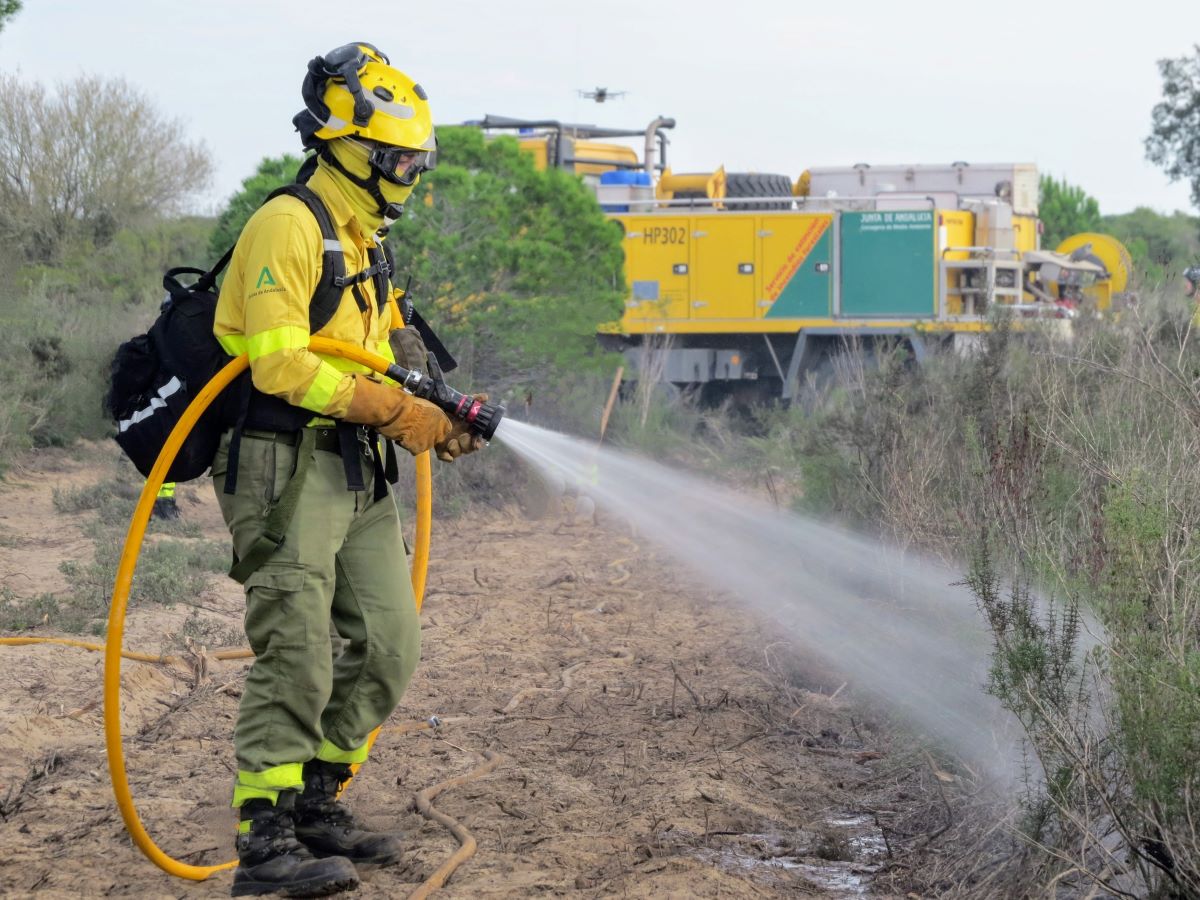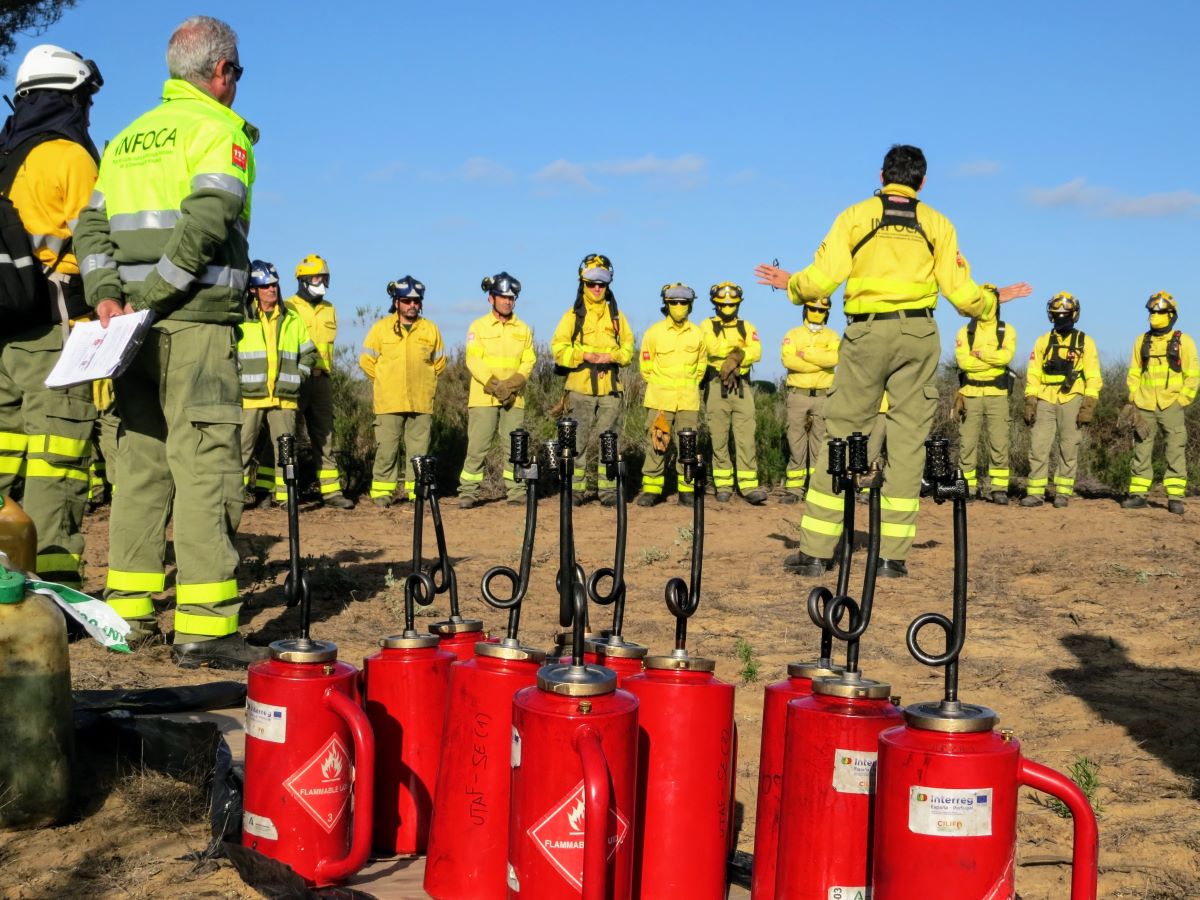Las quemas prescritas de Doñana favorecen a las poblaciones de conejo, principal presa del lince ibérico y el águila imperial

Prescribed burning in the Doñana Biological Reserve / Photo: José Manuel Vidal Cordero
La Reserva Biológica de Doñana ha sido escenario de unas quemas prescritas que han sido desarrolladas en la Infraestructura Científico-Técnica Singular de Doñana (ICTS-Doñana) del Consejo Superior de Investigaciones Científicas (CSIC) en el marco del proyecto de investigación del Plan Nacional ECOFIRE con el objetivo de mejorar el hábitat mediante la eliminación del matorral senescente, es decir, el ya envejecido. Esta es la práctica adecuada para que pueda crecer pasto de calidad y, de esta forma, favorecer a las poblaciones de conejo, una especie en declive en Doñana que, sin embargo, es la principal presa de dos emblemáticos depredadores de la zona: el lince ibérico y el águila imperial.
Xim Cerdá, investigador científico del CSIC en la Estación Biológica de Doñana (EBD), explica que, aunque el objetivo final es la conservación del conejo, estos fuegos técnicos se utilizan para aprender más sobre la respuesta de los ecosistemas a ellos. “Usamos las parcelas como zonas experimentales en las que cuantificamos cómo varía la biodiversidad comparando con otras no quemadas: se muestrean artrópodos con trampas de suelo, mamíferos con cámaras trampa y micromamíferos con trampas Sherman, conejos mediante conteo de excrementos y murciélagos con grabadoras de ultrasonidos”, señala.
Estas quemas programadas se realizan en Doñana todos los años entre finales de octubre y principios de diciembre, ya que tienen dos limitaciones determinantes. Por un lado, la conservación de las distintas especies de aves, como el águila imperial y el milano real, que desde que inician el periodo de cría cuentan con una zona de exclusión en el entorno de los nidos al que no se puede acceder. Y, por otro lado, las de carácter administrativo, que conllevan la finalización del periodo de riesgo alto de incendio.

Desarrollo de una quema prescrita en la Reserva Biológica de Doñana / Fotografía: José Manuel Vidal Cordero
En este sentido, la meteorología es determinante, ya que la quema debe realizarse dentro de una ventana de prescripción, bajo unas determinadas condiciones, para evitar que se propague y se convierta en un incendio. Cerdá comenta que “esta ventana la determinan la temperatura, el viento y la humedad, cuyos valores deben encontrarse dentro de cierto rango”.
Con la quema de las zonas de matorral, lo que se conoce localmente como monte blanco o intermedio, las parcelas quemadas tienen una enorme reducción de combustible, es decir, suponen una ayuda determinante para evitar la propagación de fuego en el Parque Nacional de Doñana. De hecho, el Plan de Emergencia por Incendios Forestales de Andalucía de la Junta de Andalucía (INFOCA) ha marcado como escenario ideal un mosaico de parcelas quemadas y no quemadas que sirviera de cortafuegos en este entorno natural.
Respecto a los beneficios generales para el Parque de las quemas prescritas, Xim Cerdá señala que “aunque en estos momentos aún estamos analizando los datos de las quemas anteriores, creemos que hay un beneficio para la conservación de la fauna. Respecto a la flora, esperábamos una mejora más evidente de los pastos pero la respuesta ha sido menor de la esperada, posiblemente debido a que estos últimos cuatro años han sido extremadamente secos”.
Historia del fuego en un ecosistema
A pesar de la justificación que tiene como proyecto de investigación, en la memoria colectiva de la sociedad aún están aquellas imágenes del incendio que sufrió Doñana en el año 2017 fruto de una negligencia y que resultó tremendamente destructivo para el Parque. Pero “las quemas prescritas son un fuego técnico controlado que sí que aportan un beneficio al ecosistema. En el fondo, estas quemas están sustituyendo a los eventos de fuegos naturales que siempre han existido en la cuenca mediterránea y que servían para ‘rejuvenecer’ la vegetación”, remarca el ecólogo.
El propio proyecto de investigación justifica que las quemas prescritas eran utilizadas desde muy antiguo por los aborígenes australianos para favorecer la caza, como también ocurría en Doñana. Tradicionalmente, en este paraje natural, se rejuvenecía el matorral mediante rozas y quemas periódicas y esta práctica debía favorecer a los conejos, que son más abundantes en zonas con pasto y baja o media cobertura vegetal.
Pero el sistema tradicional de manejo se abandonó en favor de una más intensa protección tras la creación de la Reserva y el Parque Nacional, lo que ha llevado a que el matorral envejezca y se haga tremendamente denso. Aparentemente, este cambio ha favorecido a algunos micromamíferos y a sus predadores, de forma que algunas especies que antes eran muy raras o no existían son ahora relativamente comunes, como la gineta o el cárabo. En cambio, el estado actual del matorral es muy desfavorable para los predadores especialistas en la caza de conejos como el lince y el águila imperial.
Con la participación del INFOCA
Este proyecto es la continuación natural de otros anteriores que se han llevado a cabo dentro del programa Interreg Poctep España-Portugal (CILIFO y FIREPOCTEP) en los que también se realizaron quemas en Doñana. Para su desarrollo, es imprescindible la participación del Plan de Emergencia por Incendios Forestales de Andalucía de la Junta de Andalucía (INFOCA), que se ocupa de la planificación de las quemas mediante el Equipo Regional de Quemas Prescritas de Andalucía (ERQUA).
Este servicio, al que se solicita la autorización gubernativa, prepara el Plan de Quema y visita las parcelas seleccionadas junto con el equipo de la ICTS-Doñana.

Efectivos del INFOCA en la Reserva Biológica de Doñana / Fotografía: José Manuel Vidal Cordero
Xim Cerdá es investigador científico del CSIC en la Estación Biológica de Doñana, a donde llegó hace más de 25 años. Es ecólogo evolutivo y de comunidades y trabaja con hormigas como sistema modelo. Hizo su tesis doctoral en la Universidad Autónoma de Barcelona sobre el comportamiento de hormigas y, en este ámbito, ha trabajado como posdoctoral y profesor invitado en la Universidad de París 13, la de Tours y la de París 11.
En la actualidad, su investigación se centra en estudiar la ecología y evolución de la resistencia al calor de las hormigas del desierto y en los efectos del fuego sobre estas.